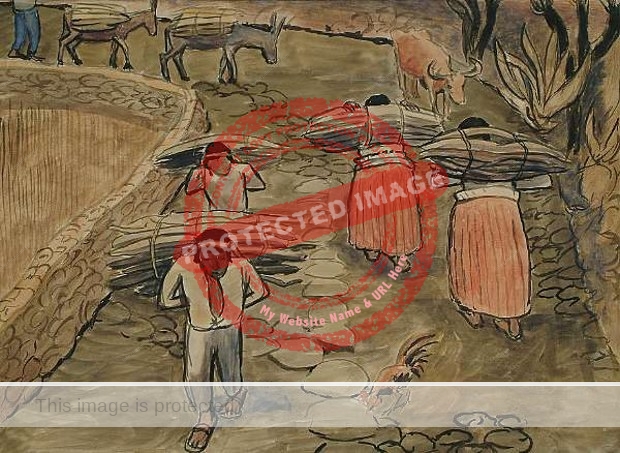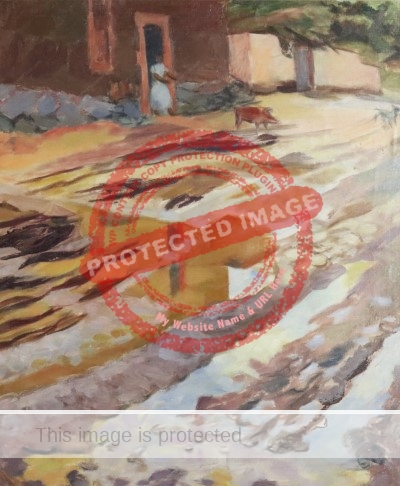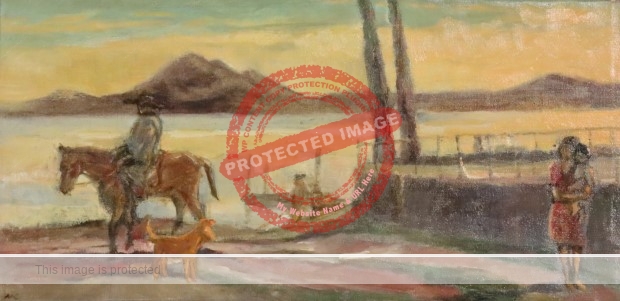Talented British artists Richard and Nancy Carline never lived in Ajijic, but did visit friends in the village more than once and completed several paintings of the area.
Richard Cotton Carline (1896-1980) was born in Oxford to a family of painters. After studying in Paris, and doing some teaching, he working on developing camouflage designs for the military before serving on the Western Front and in the Middle East as an Official War Artist during the first world war. During the second world war, Carline wrote the Ministry of Aircraft Production’s official report on industrial and aircraft camouflage; his work on camouflage projects was highlighted in a 2016 exhibition at Leamington Spa Art Gallery & Museum. The quality of his work as war artist and camouflage expert is almost unparalleled.

Richard Carline. Carrying burdens in Mexico. Credit: Christie’s.
In the interwar period, Carline taught at the Ruskin School of Drawing in Oxford and held his first solo show at the Goupil Gallery in 1931. He was an active member of the AIA (Artists’ International Association) and, according to Mexican art critic Justino Fernández [1], spent eight months in Mexico in 1936. The more commonly repeated version is that Carline visited the USA and Mexico in 1937-1938, where he was impressed by both the value of public murals and the value of encouraging them via such programs as the Federal Art Project.
In the early 1940s, on behalf of the AIA (Artists’ International Association), Carline lobbied for the UK to have a public mural program, based on those in Mexico and the US, as a way of enabling artists to contribute to the war effort. Sadly, the AIA’s efforts met with only limited success, but did not deter Carline from establishing a National Mural Council in 1943 to promote the commissioning of murals by industry. Three years later, Carline was chosen as the first Art Counsellor of UNESCO.

Richard Carline. 1975. Ajijic after rain. Credit: Canterbury Auctions
Carline was an aficionado of picture postcards and wrote Pictures in the Post: Story of the Picture Postcard and Its Place in the History of Popular Art, first published in 1959. He also wrote The Arts of West Africa (1935), Draw they Must (1968) and Stanley Spencer at War (1978).
Richard and Nancy Carline married in 1950 and had two children, one of whom (Herminone) is also a professional artist.
Nancy Mona Carline (née Higgins) (1909-2004) trained at the Slade School of Fine Art in London and then worked at the Sadlers Wells Ballet, where she met Vladimir Polunin, who encouraged her to return to the Slade and take the course he was teaching in stage design.
Nancy Carline was an ardent advocate of art education and exhibited regularly, including in shows arranged by the Royal Academy, the London Group, the New English Art Club, the Artists’ International Association, and the Wildenstein Gallery. A retrospective of her life’s work was held at the Camden Arts Centre in 1980.

Nancy Carline. Ajijic. Credit: Canterbury Auctions
Though the details of Richard Carline’s first trips to Mexico remain unclear, his later visits, accompanied by wife Nancy, were to visit Laura and Jack Bateman and their children in Ajijic. Laura Bateman ran an art gallery in Ajijic for many years. How the two couples first met each other is unclear, but they became firm friends. Based on the dates of paintings of Lake Chapala completed by the Carlines, they visited Mexico in 1967 and 1975, and perhaps on other occasions as well. Shortly after their 1975 trip, Richard Carline wrote to German artist Dr. Frederick Solomon (1899-1980) in New Hampshire explaining that he had returned to Lake Chapala because he “found it so fruitful for painting.” But, because they had bought a reduced fare ticket, “we did not have very long in Mexico – but by going to paint we can deduct this as an expense of artists from income tax.”

Nancy Carline. 1975. Mexico (Ajijic). Credit: Canterbury Auctions
Paintings by both artists were sold by the Canterbury Auction Galleries in the UK in 2020. Richard’s “After Rain Ajijic Mexico 1967” had a pencil inscription stating it had been exhibited at the London Group in 1968/9. Two Lake Chapala-related paintings by Nancy were in the same auction: “Ajijic Mexico Lake Chapala”, and “Mexico” (which had “Ajijic” and “1975″ written on the back).
The Carlines’ close friendship with the Bateman family had another very significant link to the Lake Chapala art world. The Bateman’s eldest daughter, Alice, after attending a village school in Ajijic, studied art for a year at the University of Guadalajara in 1963. The following year Alice lived with the Carlines in London, when she moved to the UK to study at the Byam Shaw School of Art (now Central Saint Martins College of Arts and Design). Alice Bateman, who later also studied sculpting in Italy, lives in Texas and has enjoyed a stellar career as a sculptor.
Several chapters of Foreign Footprints in Ajijic: Decades of Change in a Mexican Village offer more details about the history of the artistic community in Ajijic.
Reference
- [1] Justino Fernández. 1969. Catálogo de las Exposiciones de Arte en el año 1968. Anales del Instituto de Investigaciones Estéticas, Mexico.
Comments, corrections or additional material related to any of the writers and artists featured in our series of mini-bios are welcomed. Please use the comments feature at the bottom of individual posts, or email us.
Tony Burton’s books include “Lake Chapala: A Postcard History” (2022), “Foreign Footprints in Ajijic” (2022), “If Walls Could Talk: Chapala’s historic buildings and their former occupants” (2020), (available in translation as “Si Las Paredes Hablaran”), “Mexican Kaleidoscope” (2016), and “Lake Chapala Through the Ages” (2008).